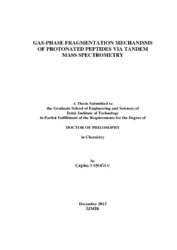Please use this identifier to cite or link to this item:
https://hdl.handle.net/11147/2961Full metadata record
| DC Field | Value | Language |
|---|---|---|
| dc.contributor.advisor | Yalçın, Talat | - |
| dc.contributor.author | Taşoğlu, Çağdaş | - |
| dc.date.accessioned | 2014-07-22T13:48:40Z | - |
| dc.date.available | 2014-07-22T13:48:40Z | - |
| dc.date.issued | 2013 | - |
| dc.identifier.uri | http://hdl.handle.net/11147/2961 | - |
| dc.description | Thesis (Doctoral)--İzmir Institute of Technology, Chemistry, İzmir, 2013 | en_US |
| dc.description | Includes bibliographical references (leaves: 76-83) | en_US |
| dc.description | Text in English; Abstract: Turkish and English | en_US |
| dc.description | xiv, 84 leaves | en_US |
| dc.description | Full text release delayed at author's request until 2017.02.13 | en_US |
| dc.description.abstract | Protein identification based on enzymatic digestion of proteins and tandem mass spectrometric (MS/MS) analysis of peptide fragments has become a more popular method than classical approaches like Edman degradation. However, today’s protein sequencing tools have been constructed on a limited basis of peptide fragmentation chemistry such that some peptides can fragment in unusual ways that may not be predicted by the current bioinformatics software. Thus, erroneous assignments can be done in protein identification, which can lead to vital problems. Herein, it was aimed to reveal the rich chemistry lying behind the gas-phase fragmentation of peptides containing specific residues using MS/MS and collision induced dissociation (CID) analysis. As a result, the implementation of more detailed peptide fragmentation mechanisms into bioinformatics algorithms will no doubt help to improve database search tools. Results clearly indicate that b6 and b7 ions have higher tendency towards macrocyclization when compared to b5 ions. Besides it was observed that neighboring amino acid influences the selective opening of the macrocyclic structure and no preferential cleavage order can be specified depending on the amino acid residue. Next study showed that proline-containing peptides have high tendency to place the proline residue in the N-terminal position during the ring opening of macrocyclic structure. This is then followed by dipeptide elimination of proline with its adjacent C-terminal residue. Moreover, we demonstrated that sequence-scrambling exists for all histidine-containing peptides whatever the residue position and neighbor residue is. Additionally, we suggest that α-amino-ε-caprolactam formation at the side chain of lysine prevents macrocyclization reaction of b7 when K is positioned at the C-terminus. Finally, it was observed that macrocyclization reaction proceeds for peptides containing arginine when arginine gets closer to the C-terminus. Besides arginine was found to behave like lysine and forms ornithine when located at the C-terminus. | en_US |
| dc.language.iso | en | en_US |
| dc.publisher | Izmir Institute of Technology | en_US |
| dc.rights | info:eu-repo/semantics/openAccess | en_US |
| dc.subject.lcsh | Peptides--Analysis | en |
| dc.subject.lcsh | Tandem mass spectrometry | en |
| dc.title | Gas-Phase Fragmentation Mechanisms of Protonated Peptides Via Tandem Mass Spectrometry | en_US |
| dc.type | Doctoral Thesis | en_US |
| dc.institutionauthor | Taşoğlu, Çağdaş | - |
| dc.department | Thesis (Doctoral)--İzmir Institute of Technology, Chemistry | en_US |
| dc.relation.publicationcategory | Tez | en_US |
| dc.identifier.wosquality | N/A | - |
| dc.identifier.scopusquality | N/A | - |
| item.openairecristype | http://purl.org/coar/resource_type/c_18cf | - |
| item.cerifentitytype | Publications | - |
| item.fulltext | With Fulltext | - |
| item.languageiso639-1 | en | - |
| item.grantfulltext | open | - |
| item.openairetype | Doctoral Thesis | - |
| Appears in Collections: | Phd Degree / Doktora | |
Files in This Item:
| File | Description | Size | Format | |
|---|---|---|---|---|
| 10013206.pdf | DoctoralThesis | 7.12 MB | Adobe PDF |  View/Open |
CORE Recommender
Page view(s)
244
checked on May 5, 2025
Download(s)
164
checked on May 5, 2025
Google ScholarTM
Check
Items in GCRIS Repository are protected by copyright, with all rights reserved, unless otherwise indicated.